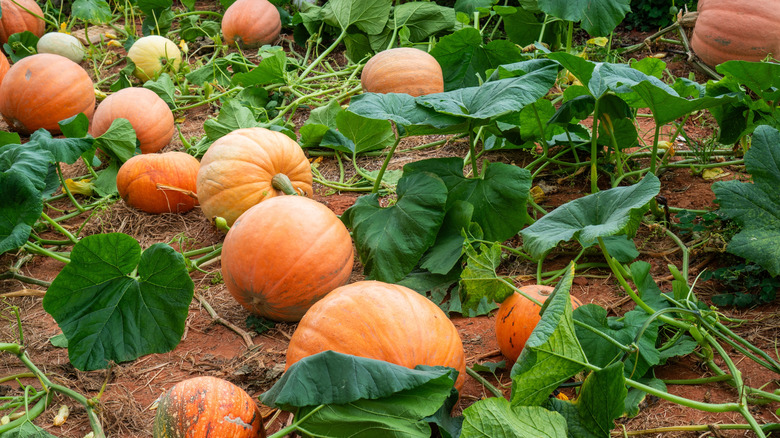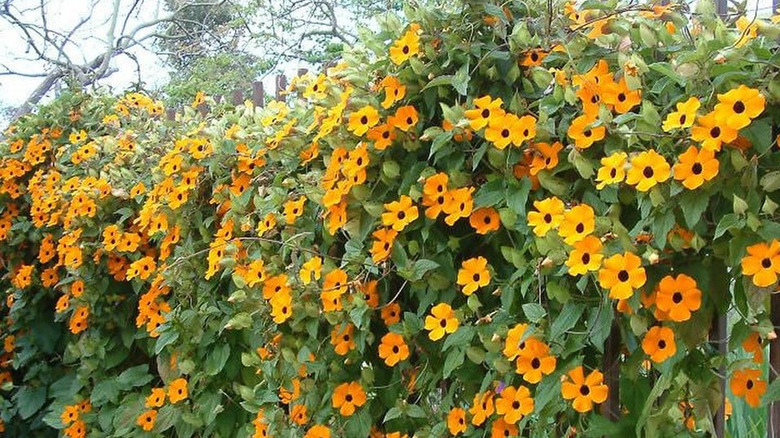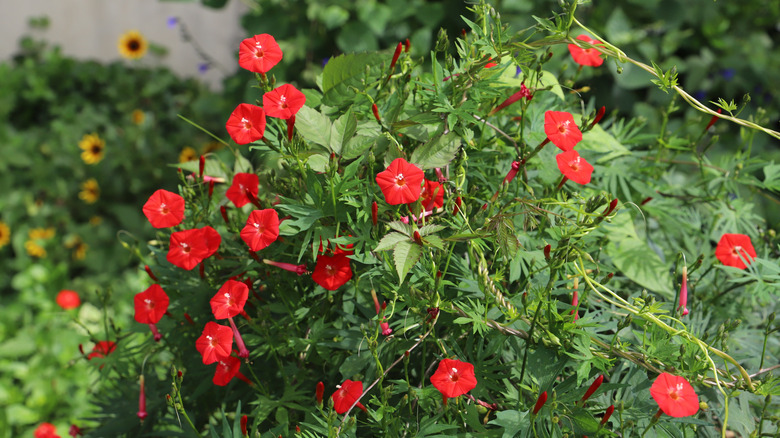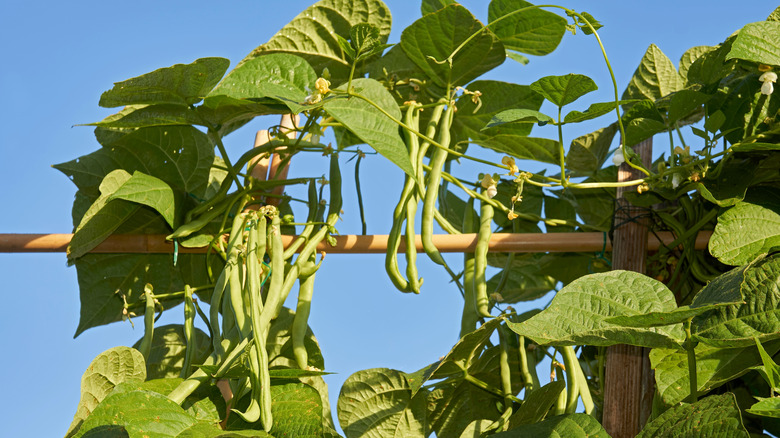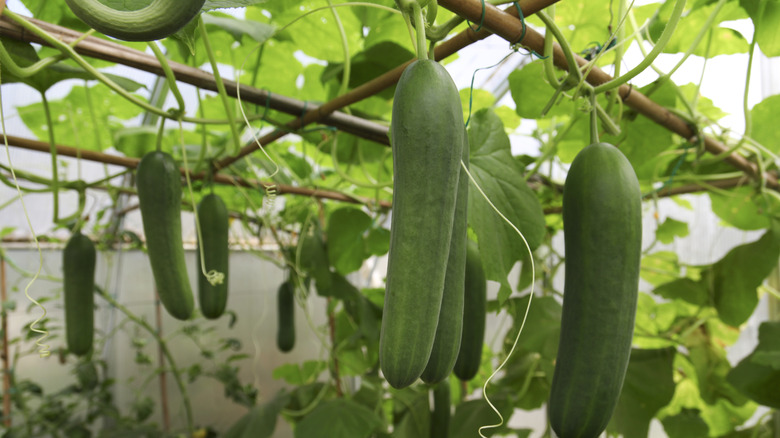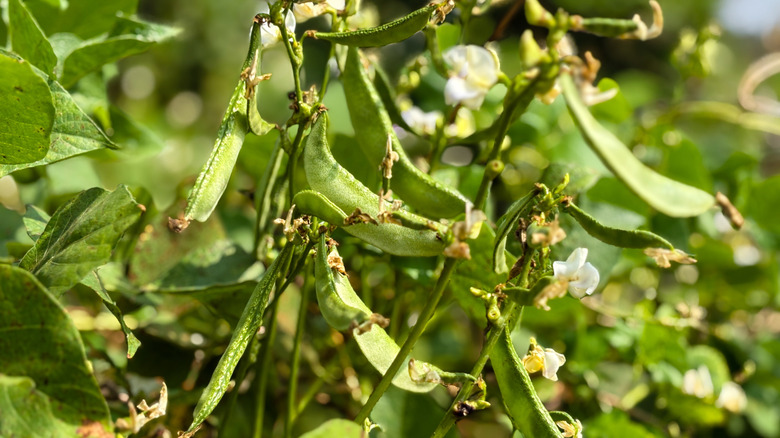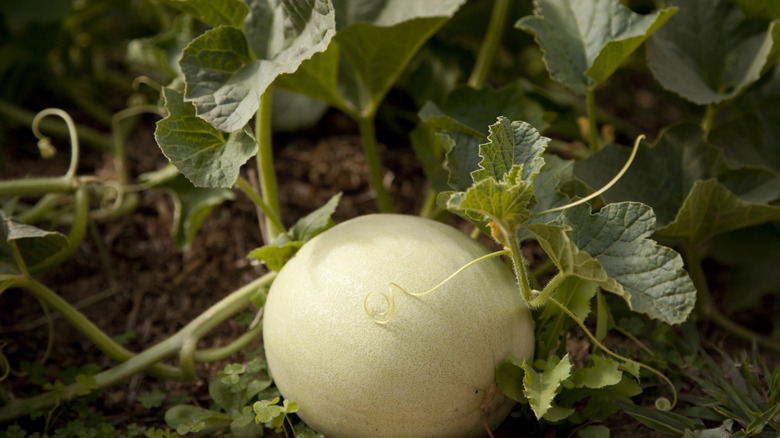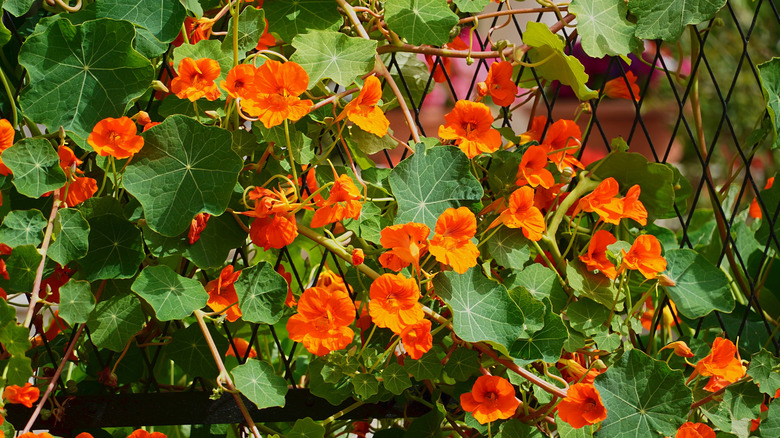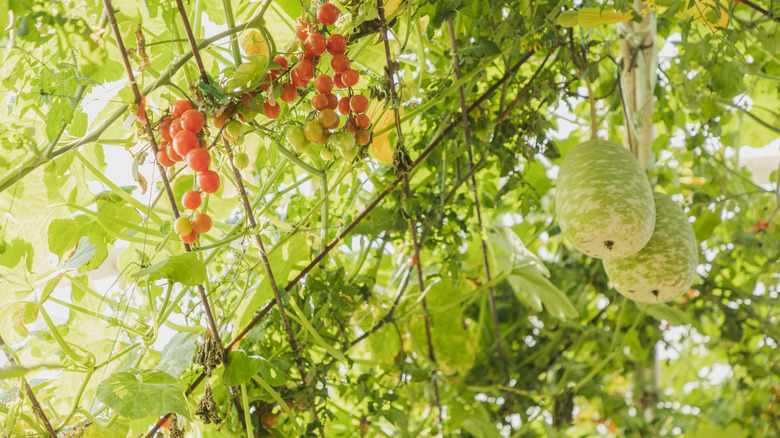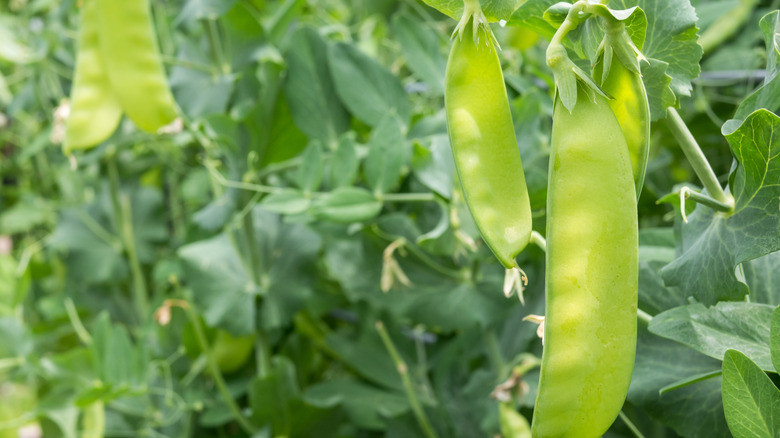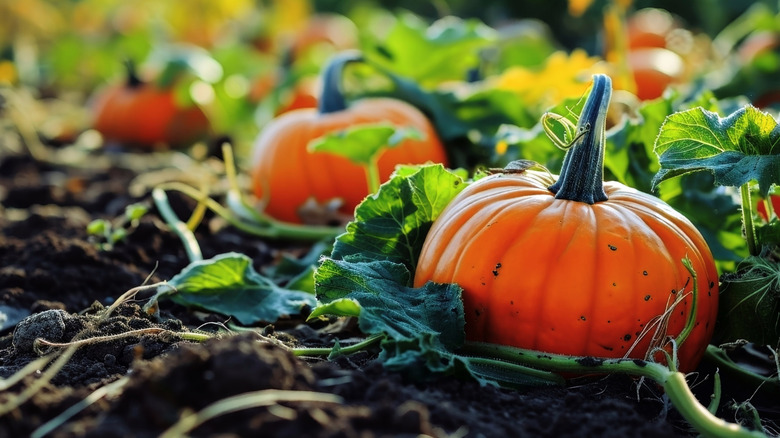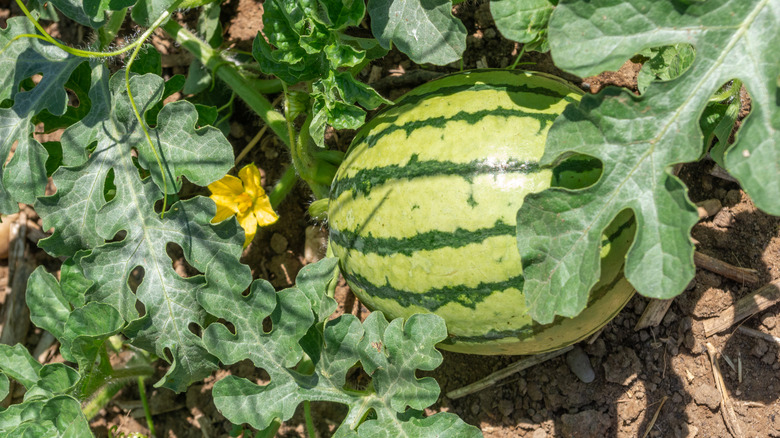12 Vine Plants That Aren't Worth Buying As Seedlings
Whether you're enhancing privacy for your patio, sprucing up a dull tree, or cultivating your own vegetables, vining plants may have been your first choice. With retailers running frequent promotions, you might even be tempted to purchase these vines as seedlings since they're fairly inexpensive. At the very least, seedlings spare you the "will they, won't they" anxiety common with seed germination. Better yet, they bloom and produce earlier than their seeded counterparts, giving you valuable extra weeks in the growth season and demanding half the effort.
Still, there are many instances when purchasing vine seedlings makes little sense. Many species develop massive top growth — think melons and cucumbers — and may become pot-bound before reaching your home, resulting in inadequate performance. Others, such as climbing beans, have delicate root systems that struggle with transplant shock and may fail to recover. Tap-rooted vines like pole peas and squash similarly resist transplantation, expressing their distress through stunted growth when forced to continue development in different soil. In short, ordering vine seedlings isn't always advantageous and can lead to disappointing results. So, to help you avoid disappointments and encourage smarter investments, we've compiled a ready list of vine plants that aren't worth buying as seedlings. Follow through below to learn more about them.
Black-eyed Susan vine
Not to be mistaken for black-eyed Susan (Rudbeckia hirta), black-eyed Susan vine (Thunbergia alata) is another plant you should ideally get as seeds. Except for zones 9 and 10, they're annuals and can put out fast growth in optimal conditions, making the seedling expense excessive. Also, seed-grown vines grow more robust vis-à-vis other propagation techniques. However, in cold climates, like the upper Midwest, you may consider starting the pea-sized seeds indoors to make up for the short growth season. Do check with your local extension before planting, as these vines can grow weedy.
Cardinal climber
Like the black-eyed Susan vine, cardinal climber (Ipomoea sloteri) is an annual vine (save for zones 11 and 12) best grown with seeds. To encourage emergence in under two weeks, nick the hard outer coat with a filer or sand it down and leave the seeds in warm water for the night. Wait until all frost danger is past before direct sowing, or the vines won't be as vigorous. While you could start the seeds indoors, do so in degradable pots to spare the roots transplant shock — they abhor any disturbance.
Climbing beans
Whether you're growing winged, long, or pole beans, collectively called climbing beans, avoid growing them using seedlings. These bean varieties have fragile root systems that easily take damage when moved elsewhere, affecting yields. That's why it's usually better to directly seed bean plants in your garden. Since their seeds are a substantial size, they already have lots of stored energy and can push out seedlings in under 10 days. Just make sure the soil is sufficiently warm (about 65 degrees Fahrenheit or higher) and receives at least six hours of direct sunlight. Also, be mindful of the roots during weeding.
Cucumbers
Like pumpkins, cucumbers can be grown in hills or mounds to give their vines expansive space to spread, unless they're being trained to go over a trellis. Regardless of the method, cucumbers should ideally be directly sown into your garden soil when it's about 70 degrees Fahrenheit. The other alternative that involves removing seedlings from their nursery pots and plopping them into the ground entails the risk of damaging their taproots, over which the yields might suffer. They can also be root-bound. Don't forget to wrap a row cover around your seedlings to limit damage from flea and cucumber beetles.
Hyacinth bean
Indian or hyacinth beans (Lablab purpureus) don't respond well to transplantation. So, to avoid shocking their roots into submission, directly sow the seeds into the soil when temperatures soar to 70 degrees Fahrenheit — even beginners can grow them easily using seeds. To improve germination rates, saturate the seeds with warm water, overnight. But if you've missed the planting bus because mercury is reaching past 90 degrees Fahrenheit or because you don't enjoy a sufficiently warm season, pop the seeds in compostable pots about six to eight weeks before the last frost.
Melons
If you find melon seedlings propped in 2-inch-wide pots, reconsider your purchase. This is because they might have tangled roots. These mighty plants grow a bunch of deep, sensitive roots that take offense when forced to re-establish in a different soil. Plus, if they get cut during transplantation, you can lose out on a good harvest, if not the whole plant. However, if your growth season is extremely short, start seeds indoors in 4-inch-wide biodegradable pots, allowing the roots sufficient room for expansion. Transplant the whole container when two true leaves sprout.
Nasturtiums
Before you snag trailing varieties of nasturtiums (Tropaeolum majus) from the shelf, know you should never buy these flowers as seedlings because their roots resent transplantation. Luckily, nasturtiums grow easily with seeds. After frost, when the soil warms to between 55 and 65 degrees Fahrenheit, sow the seeds and expect seedlings in about a week or so. You can water soak them overnight for faster growth. Starting seeds indoors is ill-advised. But if that's your only recourse, make sure to bury them in biodegradable pots that can be planted in garden soil.
Ornamental gourds
All that humongous vine growth on ornamental gourds isn't for show; their fibrous roots experience similar expansive growth, like the fruits. They truly are fast-growing, which is why you must avoid purchasing them as seedlings, and sow seeds instead. In fertile, warm soils, they can germinate in under a week or less, though it could be slightly longer in cold zones. If you think there isn't sufficient time for the gourds to mature into mammoth ornamentals before freezing, pop the overnight soaked seeds into 4-inch peat containers and transplant when four true leaves sprout.
Pole peas
Pole peas, like snow or sugar snap, typically require trellis support. So, start them as seeds, rather than purchased seedlings. Over time, pea plants develop a long taproot that can grow over 3 feet. Besides, they grow many shallow feeder roots that dislike any disturbance. To stave off root damage, it's recommended to pop the easy DIY pea trellis you made on a budget before the seeds take off. Another worrying aspect? Peas carry root nodules inhibited by nitrogen-fixing bacteria, which can be damaged during transplantation. This consequently impairs nutrient intake.
Pumpkins
There is a reason pumpkin seeds are buried in mounded soil. To support their 20-foot-long vines, they must grow an extensive root system for proper anchorage. By the time you're ready to site transplants — even those started indoors — they'll have developed a sizable number of roots that can be harmed when pushed into the soil. If damaged, your plants will experience stunting. So, to avoid such outcomes, sow pumpkin seeds directly into mounds. But if you'd like a head start, start them in peat pellets and bury the entire thing after three weeks to minimize root disturbance.
Squash
The fact that squash features among drought-tolerant vegetables to add to your garden should clue you in as to why they won't perform well when purchased as seedlings. They sprout deep taproots and an extensive system of lateral feeder roots to support their top growth — quickly at that. This raises the odds of the squash becoming root-bound in the nursery pots, bearing bad news for growth. So, do these veggies a favor and seed them directly into warm soil. Plus, starting and growing them indoors for two weeks only to transplant them into the soil with their degradable pots attached is ill-advised.
Watermelons
Those in cold climates might try to save time by purchasing watermelon seedlings as they mature two weeks sooner than their seeded counterparts. However, unless you find them in peat pots or soil blocks, you're better off dropping the idea. Transplanted roots grow stressed and may not succeed in fostering a deeper taproot, leading to premature root drying and poor yields. They may never recover if they're pot-bound. So, it's best to grow watermelon from seed for a deliciously juicy harvest. Alternatively, start seeds in 1 ½ inch wide pots and transplant when they develop a pair of mature leaves.
